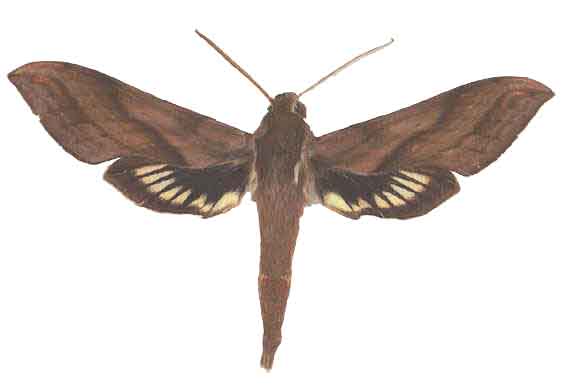Xylophanes norfolki
Xylophanes norfolki
Kernbach, 1962

This site has been created by
Bill Oehlke at oehlkew@islandtelecom.com
Comments, suggestions and/or additional information are welcomed by Bill.
TAXONOMY:
Family: Sphingidae, Latreille, 1802
Subfamily: Macroglossinae, Harris, 1839
Tribe: Macroglossini, Harris, 1839
Genus: Xylophanes Hubner [1819] ...........
Species: norfolki Kernbach, 1962
|
MIDI MUSIC
.....It's a Wonderful World.....
copyright C. Odenkirk
ON.OFF
<bgsound src="world.mid" LOOP=FOREVER>
|
DISTRIBUTION:
Xylophanes norfolki moths
are endemic on the Galapagos Islands.
"Similar to the Xylophanes tersa species group with regard to the hindwing upperside and male genitalia but markedly different in the pattern of the forewing upperside.
Forewing not so elongate and falcate as in Xylophanes tersa tersa, and with a slightly more convex outer margin.
MaleMedian stripe of tegula dark orange.
Wingspan: 57.8 mm (n = 4).
Lateral stripes of abdomen formed from a series of diffuse patches of yellow and orange scales.
Underside of abdomen purplish-brown.
Forewing upperside similar to Xylophanes tersa tersa but with a darker brown ground colour and differing markedly in the arrangement of the lines and bands: antemedian band strong, directed distally as far as Cu then sharply angled back to the costa; first postmedian line not directed towards the apex but following a parallel contour to the antemedian line but not so sharply recurved towards the costa distally; second and third postmedian lines weak; fourth postmedian line oriented more transversely, angled sharply towards the apex at Rs4, thickened between Rs4 and M3; fifth postmedian line weak, parallel to fourth postmedian line; submarginal line crenulated.
Forewing underside similar to Xylophanes tersa tersa but: ground colour darker orange; postmedian band strong and crenulated; marginal band darker grey.
Hindwing upperside as in Xylophanes tersa tersa but pale yellow spots of the median band longer.
Hindwing underside similar to Xylophanes tersa tersa but: ground colour darker orange; postmedian band strong and crenulated; marginal band darker grey." CATE

Xylophanes norfolki male, Galapagos Islands, CATE,
on my home computer only.
FLIGHT TIMES:
Xylophanes norfolki adults fly in
February and June, with a possible later flight in September-October.
ECLOSION:
Pupae probably wiggle to surface from
subterranean chambers just prior to eclosion.
SCENTING AND MATING:Females call in the males with a pheromone released from a gland at the tip of the
abdomen.
EGGS, LARVAE, PUPAE:
Larvae feed on white wild coffee
(Psychotria rufipes).
Moths probably emerge approximately one-two months after larvae pupate.
Use your browser "Back" button to return to the previous page.
Goto Main Sphingidae Index
Goto Macroglossini Tribe
Goto Central American Indices
Goto Carribean Islands
Goto South American Indices
Goto U.S.A. tables

